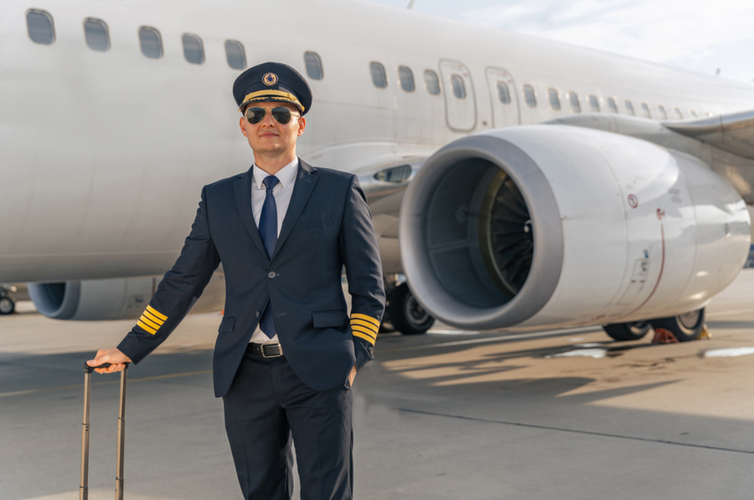Posted by Richard G. on Jan 8th 2025
Aviation is more than just a career; it's a calling that beckons those with a passion for the skies. If you've been dreaming of a life in the cockpit and are ready to take your aviation journey to new heights, obtaining an Airline Transport Pilot's License (ATPL) is your key to success.
In this guide, we'll navigate through the essential information you need to know about becoming an airline transport pilot. From understanding the significance of an ATPL to the requirements and steps involved in acquiring one, we'll ensure your path to the flight deck is as clear as a cloudless sky.
What is an Airline Transport Pilot Certificate?
A career as an Airline Transport Pilot (ATP) allows you to reach the pinnacle of commercial aviation, enabling you to carry passengers or cargo for compensation or hired on a scheduled airline.
With an ATP certificate, you can embark on an exciting career path, piloting large commercial jets on scheduled routes across the globe. Airlines often hire pilots who meet their minimum flight time requirements and provide comprehensive ground school training to prepare them for the role.
Eligibility Requirements for an Airline Transport Pilot License
Before you start plotting your course to become an airline transport pilot, you need to check if you meet all the entry points. Interestingly enough, various requirements are dependent on acquiring an ATP or R-ATP (Restricted ATP) :
- Age: You need to be at least 23 years old for ATP and 21 years old for R-ATP
- Flight Hours: You need to clock in at least 1,500 flight hours. For an R-ATP, one can be eligible at 750, 1,000, or 1,250 hours.
- Training: Complete required training through simulations and classroom ground school.
- Pilot Certificate: You need to hold a commercial pilot certificate with an instrument rating.
Let's go through each of these:
To qualify for an Airline Transport Pilot (ATP) certificate, candidates must be at least 23 years old, while those aiming for a Restricted ATP (R-ATP) certificate need to be at least 21 years old. These age requirements ensure that pilots have reached a level of maturity and experience deemed necessary for the responsibilities of commercial aviation.
The FAA requires a minimum of 1,500 total flight hours to qualify for an airline transport pilot license. However, an R-ATP varies depending on the college program or military aviation experience, one can be eligible at 750, 1,000, or 1,250 hours. It's important to note that specific commercial carriers may have their own requirements, such as a certain number of hours in various conditions or types of aircraft.
You will need to complete extensive training through flight simulations and classroom ground school. This training will cover advanced topics such as aircraft systems, navigation, and emergency procedures, perfecting your skills, and learning to handle various scenarios.
Before pursuing an airline transport pilot license, you must already hold a commercial pilot certificate with an instrument rating. This demonstrates that you have the necessary skills and knowledge to operate aircraft safely and effectively.
How to Apply for Your Airline Transport Pilot License
To begin your application, utilize the Integrated Airman Certification and Rating Application (IACRA) platform. This online system streamlines the process by allowing you to complete and submit your application virtually.
Roll up your sleeves for you have not one, but two exams to conquer:
Written Exam: This electronic test covers a spectrum of subjects including advanced weather, navigation, and flight operations at the airline transport pilot level.
Practical Exam ('Checkride'): Post the written success, gear up for the practical exam which consists of an oral and flight portion. The oral exam tests your advanced aeronautical knowledge, whereas the flight exam judges your capability to operate a transport category aircraft proficiently and safely.
Here are some of the key resources you'll need:
- The Pilot's Manual: ATP Certification Training Program - Main textbook for all fundamentals every airline transport pilot should know.
- ASA ACS: Airline Transport Pilot Airplane - Guide to everything that applicants for an airline transport pilot license will need to know and do for their exams.
- ASA PTS: Airline Transport Pilot - Practical test standards for the airline transport pilot exam.
- ASA Oral Exam Guide: Airline Transport Pilot - Test prep guide for the airline transport pilot oral exam.
- ASA Test Prep Plus: Airline Transport Pilot (ATP) and Flight Engineer - Test prep guide with study questions, answers, and explanations for the airline transport pilot and flight engineer exams.
License Renewal and Restrictions
Ongoing Requirements:
To maintain your ATP certification, you'll need to undergo regular proficiency checks as required by your airline.
With an ATP, you are authorized to carry passengers.
Aircraft Restrictions:
If you plan to fly aircraft weighing over 12,500 lbs or a jet aircraft, you'll need to obtain a type rating specific to that aircraft. Additionally, there are no airspace restrictions for ATP holders.
Flight Privileges:
As an ATP, you have the same privileges as a commercial pilot while now being able to fly for scheduled air carriers (airlines).
Some aircraft may require multiple crew members, but this is not a restriction on the pilot (with a few exceptions that are not applicable to airline operations).
Weather Conditions:
ATP holders are permitted to fly in all weather conditions. However, depending on the specific operation, there may be limitations on landing or takeoff in certain conditions.
Becoming an Airline Transport Pilot is a significant milestone in a professional pilot's career. With an ATP certificate, you'll have the opportunity to work for commercial airlines, carrying passengers to destinations around the world. As you embark on this exciting path, remember to stay focused on meeting the ongoing requirements, understanding aircraft restrictions, and safely exercising your flight privileges in various weather conditions. The sky, quite literally, is your limit.

